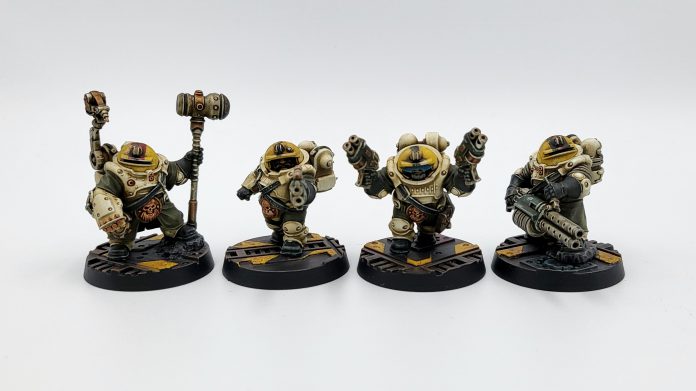Howdy scummers! It’s Monday Saturday, which means that it’s time for our Book of the Outlands review! If you’ve been jonesing to get your gang out into the Ash Wastes, this is the book for you. Many thanks to Games Workshop for providing us with a review copy.
Book of the Outlands has:
- Two full gang lists (Ash Waste Nomads & Ironhead Squat Prospectors), plus some hangers-on, brutes, and exotic beasts
- A garage full of vehicles
- Rules for making your own ride
- All of the vehicle rules (the full rundown from Ash Wastes PLUS how passengers, weapon hardpoints, etc work)
- Battlefield conditions – the Badzone-style system for generating mission hazards (also previously available in Ash Wastes)
Overall, we are pretty stoked on what this book brings to the table! Let’s get right into it.
Ash Waste Nomads
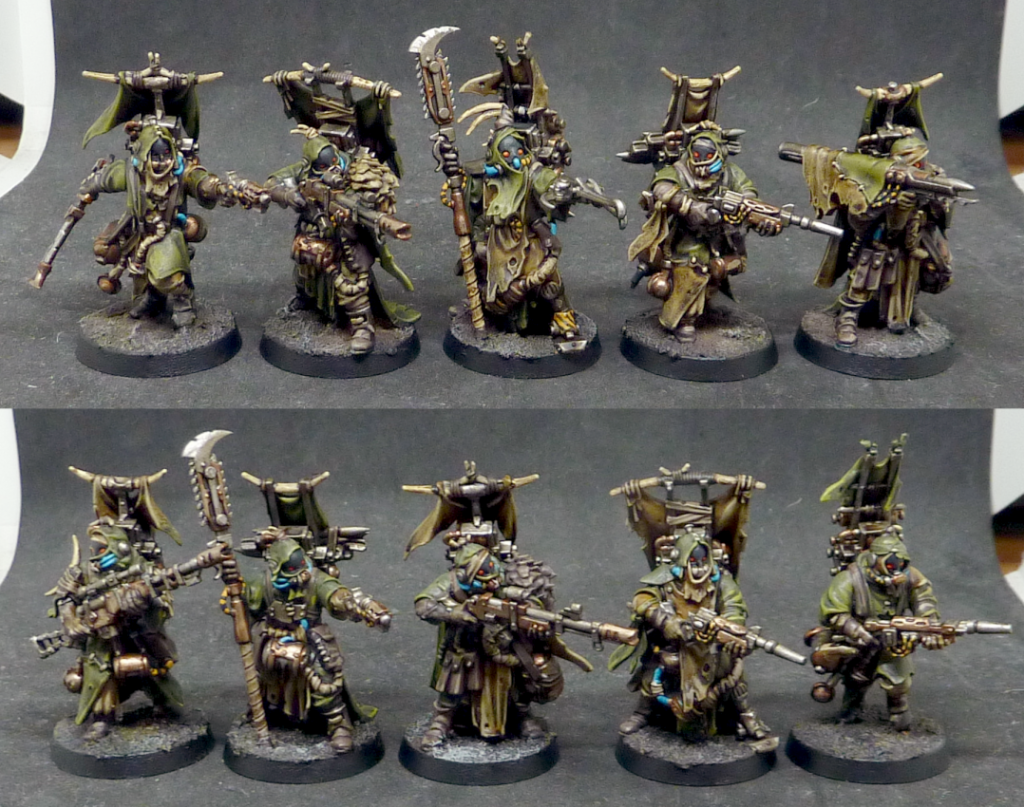
Genghis Cohen: The Ash Waste Nomads are a gang mostly designed around mobility and long ranged shooting, with some gnarly Template weapons and agile melee-capable Prospects and a Brute (the Arthromite Duneskuttler) for close quarters work.
Nomads have a Chieftain with skills and equipment designed to provide flexible melee support rather than shooting. Their more mundane Champions, Watchers, are very shooting focussed indeed, with nice Heavy & Special Weapon choices and good skills. What we hadn’t already seen in the Ash Wastes starter box was the Stormcaller, the alternate champion, although the model was previewed by Forgeworld. Like the Dust Rider Prospects, this fighter is always mounted on a Helamite, and is adaptable to melee or support roles more than shooting. Critically, it can also manipulate the Wastes’ weather systems to alter the Visibility rules in use during a game.
The Nomads’ less elite fighters can be well geared for long range firefights with medium range Basic Weapons, and the ability for their Gangers to take Long Rifles. Their close combat weapons are more limited but not terrible. Juves have very similar options but lack access to Long Rifles.
Nomads only get 2 Heavy Weapons: the already seen (and excellent) Charge Caster and the Heavy Blaster, which is roughly comparable in role to a Heavy Stubber. Their only Special Weapon options, beside the ubiquitous Long Rifles, are the Web Gun and the Venom Caster (a new Template Toxin weapon), which while fearsome, don’t offer a lot of variety. This isn’t a huge downside, as not only can Leaders and both Champion types freely use any weapons from the Trading Post, even their Prospects can go there for Pistol, Close Combat, and Special Weapons. If you ever wanted to use a meltagun to blow up a land train while riding a giant flea, you’re in luck!
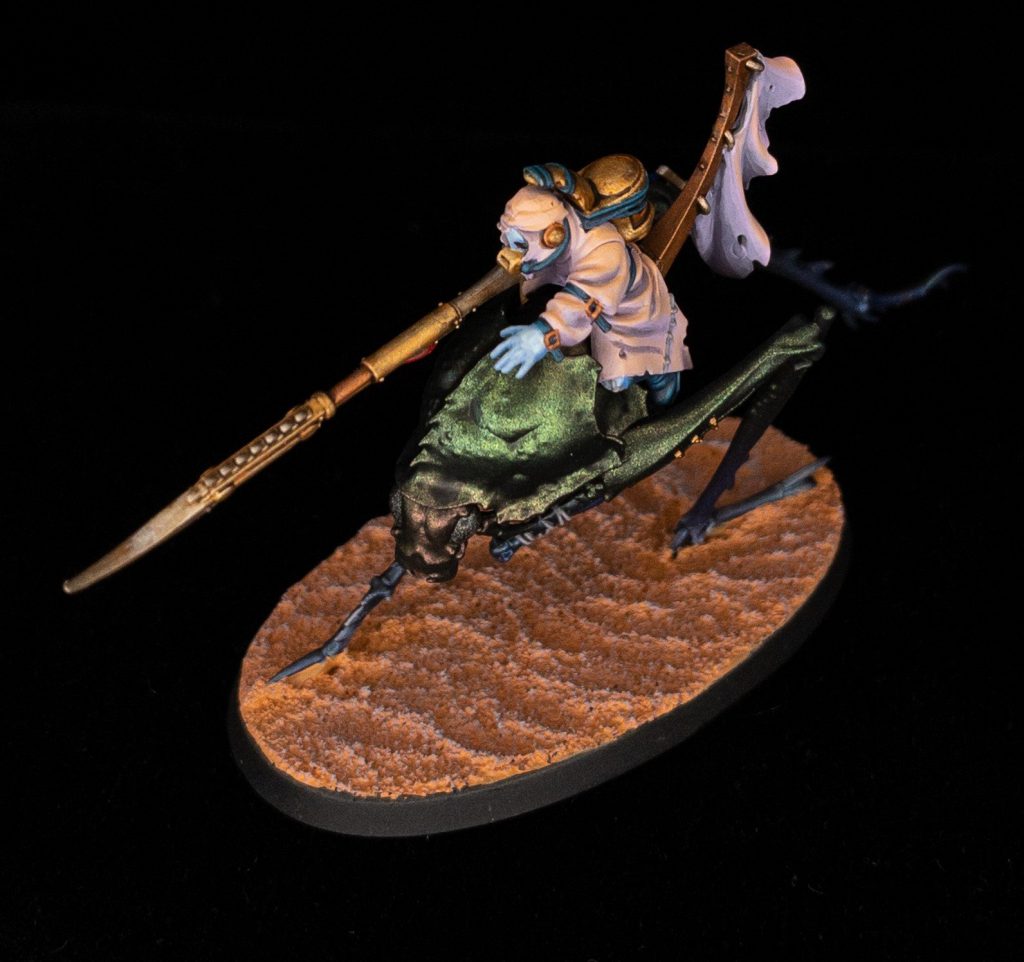
Most Nomads either have 6” Move, or are locked into Helamite mounts which grant 8” Move. They also have 3+ Initiative across the board, which is quite relevant if you want to be boarding your enemies’ vehicles during fast-moving raids.
Overall this is an interesting gang. They have excellent fire support options, ideal for the open tables of the Ash Wastes, and can no doubt manipulate Visibility to further control the shooting game. They have sufficient melee punch available for counter-charging or for mounting mobile attacks where the opponent doesn’t want them. What they don’t have is a great deal of variety in weapons or equipment. They’re more similar to a House gang before weapon packs, dedicated books and so forth were released.
Let’s take a look at the Skill trees the Nomad fighters have access to.
- Chieftain (Leader):
- Primary: Leadership, Savant, Cunning
- Secondary: Wastelands, Combat, Agility
- Watcher (Champion):
- Primary: Wastelands, Shooting
- Secondary: Leadership, Cunning, Savant
- Stormcaller (Special Champion):
- Primary: Wastelands, Savant
- Secondary: Leadership, Cunning, Combat
- Dust Rider (Prospect):
- Primary: Cunning
- Secondary: Ferocity, Agility
- Nomad Warrior Specialist:
- Primary: Agility, Cunning
- Secondary: Ferocity, Shooting
- Dust Runner (Juve):
- Primary: Cunning
- Secondary: Ferocity, Agility
- Primary: Leadership, Savant, Cunning
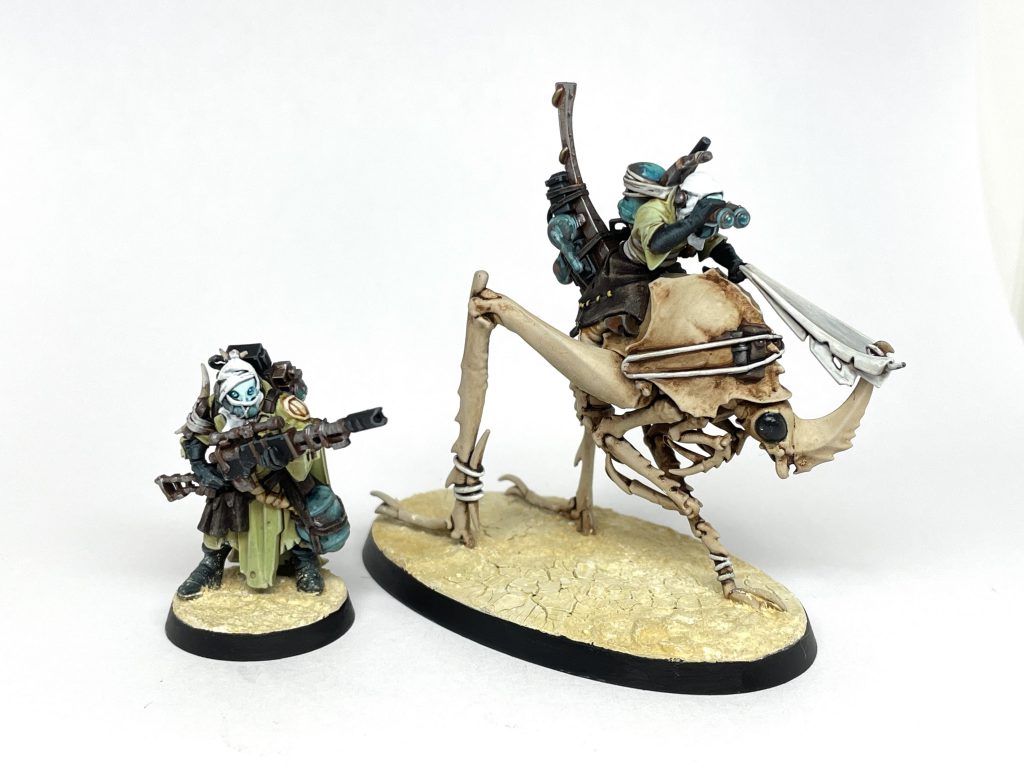
Wasteland Skills
-
- Born to the wastes. Ignore battlefield surface conditions and can use the Hide in the Wastes action even in non-wasteland scenarios. This one is highly situational. Worth it only if you play in a lot of scenarios in the deep or wild wastes, which is at least fitting for Nomads. Rating: C+, higher if playing in the Wastes.
- Stormwalker. Gain +2” to your Movement if you start your activation on the battlefield surface. Although it’s conditional, it’s not a difficult condition, and this is a significant bonus, especially when double moving. We see some utility for this, especially on the Stormcaller, who is always mounted for a base Move value of 8” – that’s some impressive mobility on a combat-capable fighter. Rating: B+
- Eyes of the Wasteland: Treat Visibility (X) as 6” higher than usual, which is OK, and see through Pitch Black conditions for 9”, also OK. Frankly both of those are useful in their situations, and irrelevant the rest of the time. The most we can say is when they do come up, they’ll make the difference between shooting and not shooting. Rating: B-, but higher if you actually are going to be playing a lot of Wastes games in the dark and/or in low Visibility.
- Beast Handler. An extra S3, AP-1, D1 attack when mounted. Meh. On paper an extra attack seems good, but combat in Necromunda is very dependant on who you’re fighting. This is a skill tree for Champions. If they haven’t downed their opponent with whatever melee weapon you’ve given them, is this basic-fighting-knife-level attack going to make up the difference? Rating: B-
- Ever Vigilant. You get to make an additional Reaction attack, and take no penalty for turning to face an attacker. This would be usable on a really resilient melee combat character, seems rather risky on most Nomads. It won’t come into play unless your opponent charges you and doesn’t manage to crush you immediately. Rating: B
- Bring it down. Gives you a special Basic Action – pick an enemy model in line of sight, and for the rest of the Round, all friendly fighters, including the user, gain re-rolls to Hit against it, and can target it regardless of Target Priority. Now this is that one skill the designers usually throw into every skill tree, the one that’s blatantly by far the best. First of all, the action itself is a straight upgrade on Aim, even if it only affected the user. As is, it seems immensely powerful, especially in campaigns where vehicles will probably need focussed fire to bring them down. Full re-rolls across any number of shooters is an enormous damage boost. An obvious pick. Rating: A
- In addition to the above, the Nomads also have access to the Arthomite Dunescuttler and a dedicated hanger-on that functions as a handler for it. The scuttler is a S5/T5 with 3 wounds, Carapace Armor, a 6″, plus the ability to climb without movement penalty. The Nomad Arthromite Herder has two key functions: 1. If the mite is hurt: he can either downgrade a critically injured Arthromite to merely going into recovery or remove a lasting injury. 2. If the mite makes it through the battle he gives it a shot at an extra 3XP. 250 credits is a lot to ask for a herder and mite combo, but the wall-crawling shenanigans could help to take out squishy snipers hiding at the top of terrain.
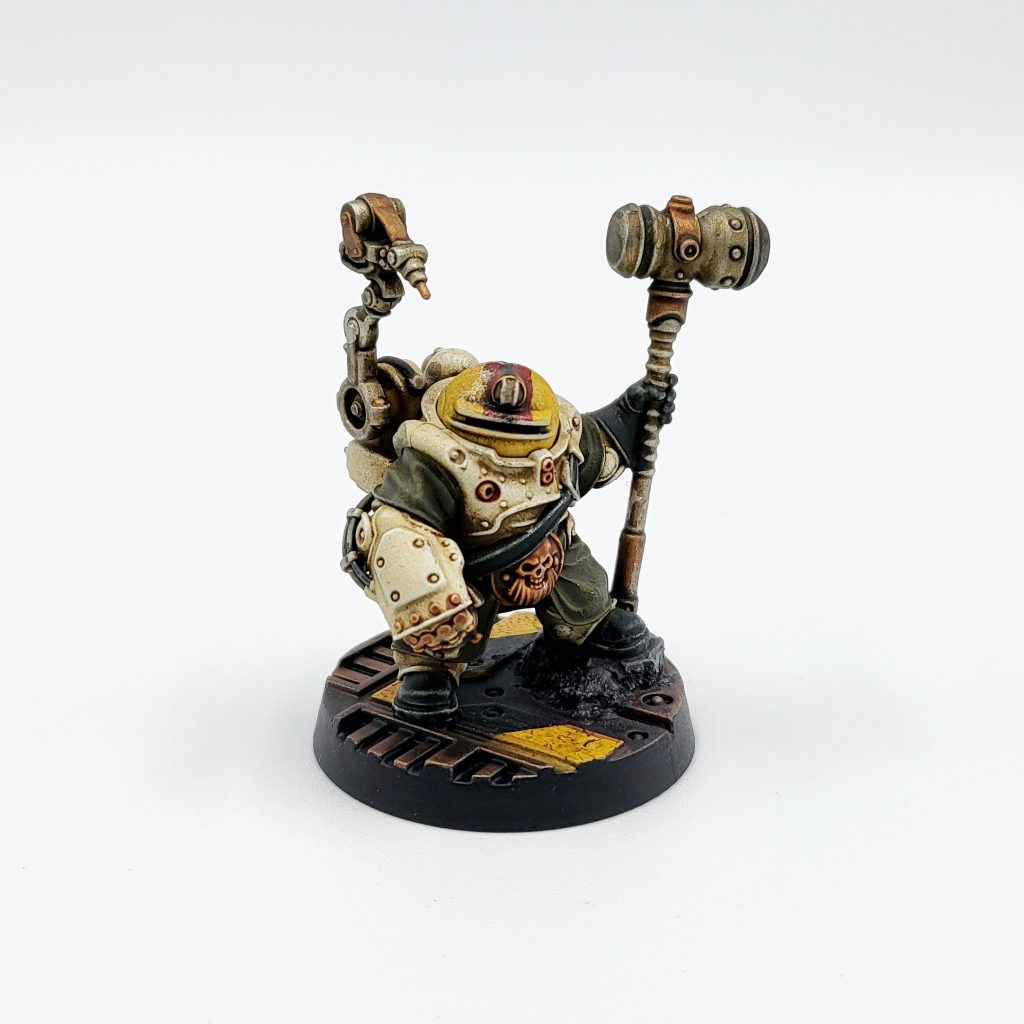
Ironhead Squat Prospectors
Genghis Cohen: This gang does seem to have its own defined and powerful niche, not quite like any one other gang. They don’t have any special alternative Champion types or Prospects – they don’t have quite the depth of a House gang with its own full book, although they do get plenty of unique weapons, their own skill tree and a Brute.Their fighter, weapon and equipment spread sort of mirrors House Orlock, with a very powerful, versatile leader, Champions built for shooting, solid shooting Gangers and Juves that are basically worse Gangers. They have T4 and Move 4” as their basic profile, so they’re as tough and cumbersome as House Goliath. They don’t have an improved Ballistic Skill, but their powerful weaponry and wide access to the Shooting skills make them nearly as good at range as House Van Saar. To cap all this off, the Squats themselves aren’t expensive fighters, although their weapons do tend to be improved ( and hence more costly) versions of existing kit.
Prospectors obey all the normal Gang Composition rules we’re accustomed to from the House books: you need at least as many Juves and Gangers as you have Champions and your one Leader. The Leader and Champions can take weapons or wargear from the Trading Post or Black Market, while Gangers and Juves can shop for wargear, but must use weapons from their own armoury.
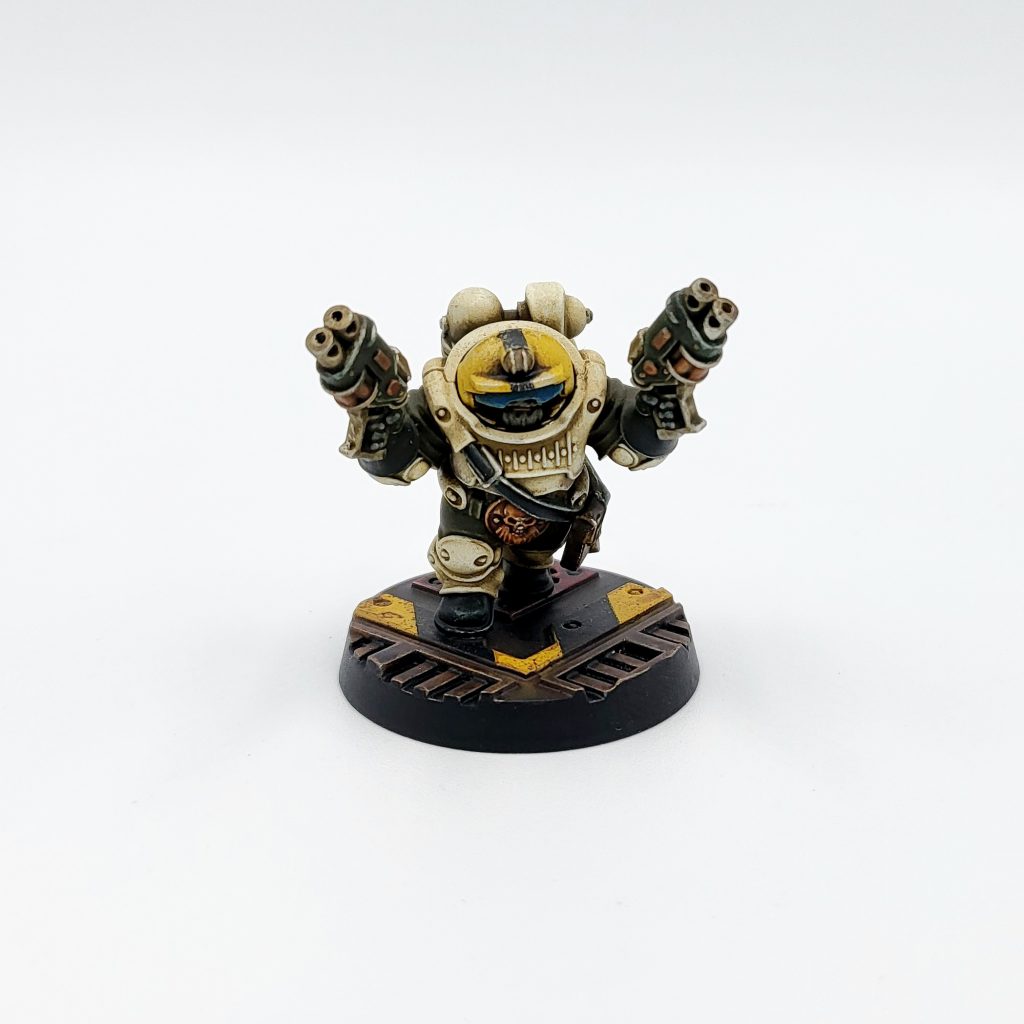
- Skills
- The gang gets the following skill trees:
-
- Charter Master (Leader):
- Primary: Leadership, Shooting, Brawn
- Secondary: Wisdom of the Ancients, Combat, Savant
- Drill Master (Champion):
- Primary: Wisdom of the Ancients, Brawn
- Secondary: Shooting, Ferocity, Leadership
- Drill-Kyn Specialist:
- Primary: Shooting, Brawn
- Secondary: Combat, Cunning
- Digger (Juve):
- Primary: Shooting
- Secondary: Brawn, Combat
- Gearhead (Crew):
- Primary: Driving, Shooting
- Secondary: Leadership, Savant
- Vartijan Exo-Driller (Brute):
- Primary: Ferocity
- Secondary: Wisdom of the Ancients, Brawn, Shooting
- Charter Master (Leader):
-
- The gang gets the following skill trees:
So, remembering that as we’ve complained about before in Necromunda, only Primary skills really matter, the first things that jump out is that your Leader, Specialists and Juves can pick from Shooting, perhaps the best skill set in the game, and one which chimes perfectly with your array of weapons. Oddly enough, the Drill Masters, who seem designed to be shooting Champions, cannot, they are instead your only models who can pick from the new unique skills, so let’s look at those.
Wisdom of the Ancients
- Where there’s scrap, there’s creds: This skill gives you D6x10 credits for each enemy vehicle you wrecked during a battle. The user doesn’t even need to have taken part, although it can’t be used if they are in Recovery. This is a pretty damn great income-generation skill if you’re playing in the Mad Max, vehicle-mounted campaigns we’re all envisioning for Ash Wastes. Clearly not every game even in one of those campaigns will be vehicle-mounted, or you could play against Ash Wastes Nomads, and of course you are gambling on actually doing some damage to the enemy’s motor pool. But it can spike a lot more income than other money-generating skills such as Fixer. Rating: A+ provided you’re in a vehicle-heavy Ash Wastes campaign. F if you’re playing in the Underhive without vehicles, or your only gaming buddy is a filthy Nomad.
- Nobody pushes Kin around: This makes you immovable by traits like Knockback, or skills like Hurl. You also auto-pass tests for falling by virtue of going Prone next to a ledge. This is pretty relevant, all the more so if your game plan for a heavily armed Drill Master is to stand him on a moving vehicle to fire at the enemy! While it’s a neat way to mitigate Squats’ poor Initiative, ultimately it’s not a very active skill. Rating: B-
- Chemical bonds never break: You can use chems twice before deleting them from your card. I guess theoretically if you had some chems you were absolutely dependent on and wanted to use constantly, this would be worth a decent amount of credit saving? In practice, I can’t think of anyone who really uses chems that much. Rating: F
- Dependable like Kin: You ignore the Unstable trait for weapons, and can re-roll all Ammo Checks. There aren’t actually any Unstable weapons in the Prospectors’ armoury, but the second half alone makes this a very tempting pick. As we’ll see, many Squat weapons have Rapid Fire (2) or even (3) and you need some way to mitigate ammo checks. Shame it’s not as good as the Savant skill Munitioneer, which extends the re-roll to friendly fighters around you. Rating: B+, vital for any Drill Master with a Rapid Fire (2-3) weapon choice.
- Stubborn to the Last: Shoot or Fight upon being taken Out of Action, basically. At first glance this sounds strong, and I can see it being frustrating for your opponents. Mechanically it’s a much more significant change than many skills we rate highly – extra Actions are worth more than a cheeky +1 here or there. But bear in mind that you have to lose your no doubt valuable champion from the game for the skill to trigger, making it a difficult skill to win games decisively with, although it could rescue a dangerous situation. Rating: B
- There’s always another secret: D6x10 credits when the user opens a Loot Casket. This can generate some solid income, but comparing it to ‘Where there’s scrap, there’s creds’ I don’t see Loot Caskets being as prevalent in any campaign as vehicles are in the Ash Wastes. Also, the model with the skill has to be the one opening the casket. This goes against what you actually want to do in games, which is snag the caskets with light-armed Juves while your Champions unload on the enemy. Rating: C+, maybe higher if you play the right missions.
The Ironheads also have access to a brute – the Vartijan Exo-Driller. Not quite as beefy as an Ambot, this heavy flamer-toting power suit actually specializes in sentry duty. When sentries are deployed, the Exo-Driller can be added as an additional defender – even if that takes the crew over the size.
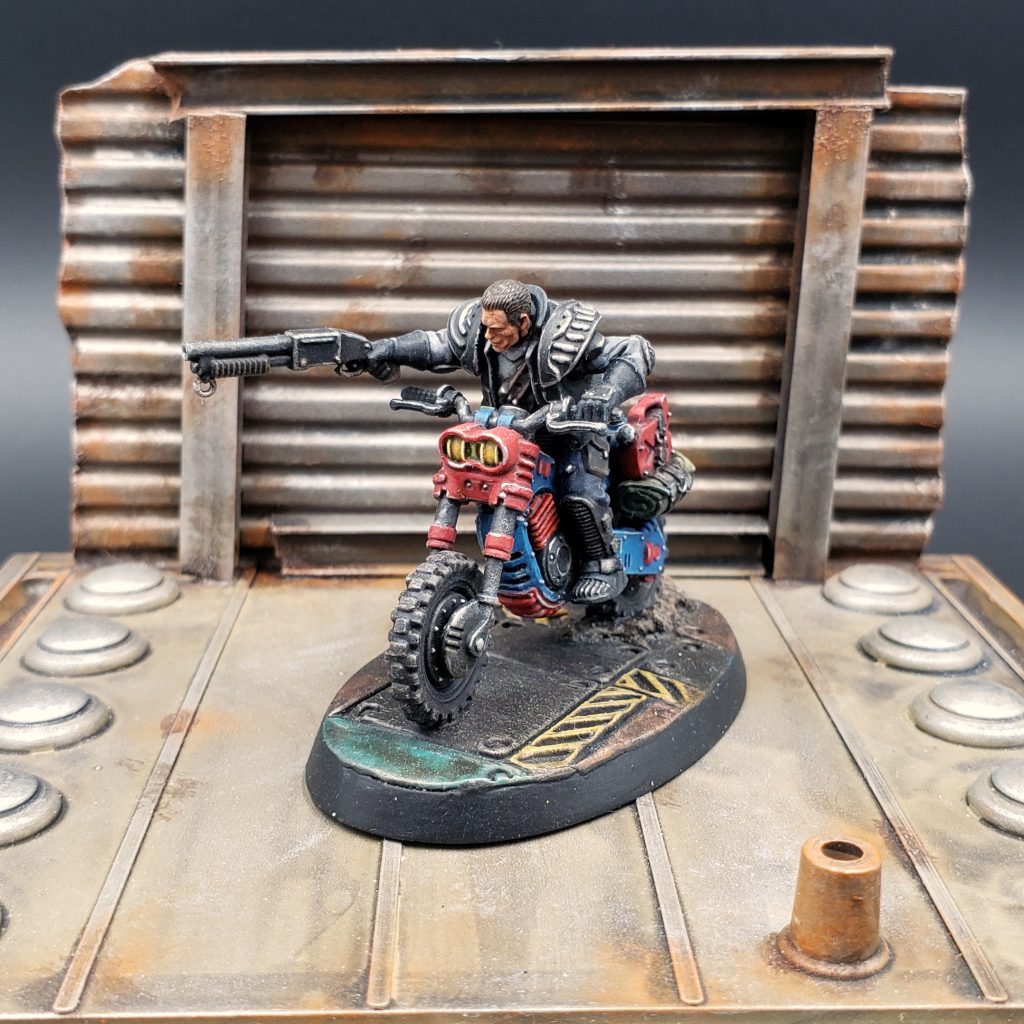
Wasteland Gangs
Fowler: Outlands’ mechanic for bringing gangs into the Ash Wastes is called Wasteland Gangs. Much like the Ash Waste campaign starting instructions, these gangs get an additional 400 credits to spend on vehicles, crew, or a fighter / piece of wargear with the Mounted condition. As the Ash Waste Nomads are unable to take vehicles, they are limited to mite riders. Other gangs have access to the Waster’s Dirtbike – a 50 credit piece of gear that gives the rider the Mounted condition and a move of 8”. The book says “all fighters” have access to the bike. You can stop holding your breath – that Atalan Jackal conversion you made with a bolter is all good!
So far, Vehicle Crews seem a bit flattened. Most dedicated drivers have access to the same limited list of gear – vehicles (a driver MUST be equipped with one), pistols, and some meager protective equipment such as Respirators. All drivers also have access to the same skill trees: Driving and Shooting as primary, Savant as secondary. Where the drivers diverge is in access and statlines. For example; all currently available Crew have BS4+, but the cheap, generic Scum Racer has 8’s nearly across the board in characteristics, whereas the Orlock specific Iron Rider has better leadership, cool, willpower, and intelligence, as does the Squats’ Gearhead which is included in their section. It’s up to you to prioritize spending a few extra credits for some slightly better checks.
What good is running around in the wasteland if you can’t can’t bring along some fearsome pets? The Outland Beastmaster (available to all gangs) chooses a species of exotic beast and can take up to three of them with him. His options are the cheap Wasteland Rat that is automatically replaced if it dies, the sneaky armored Millisaur, or the flying Ripperjck – which can entangle its foes. His expertise with his selected beast type means that his pets only need to stay within 6” of him – and he takes on one of their skills. A rat-tamer picks up their dodge skill. Wranglers of Millisaurs are able to infiltrate. Ripperjack handlers pick up catfall. The Beastmaster’s ability to adapt is super flavorful, and we are psyched to see the return of some classic creatures.
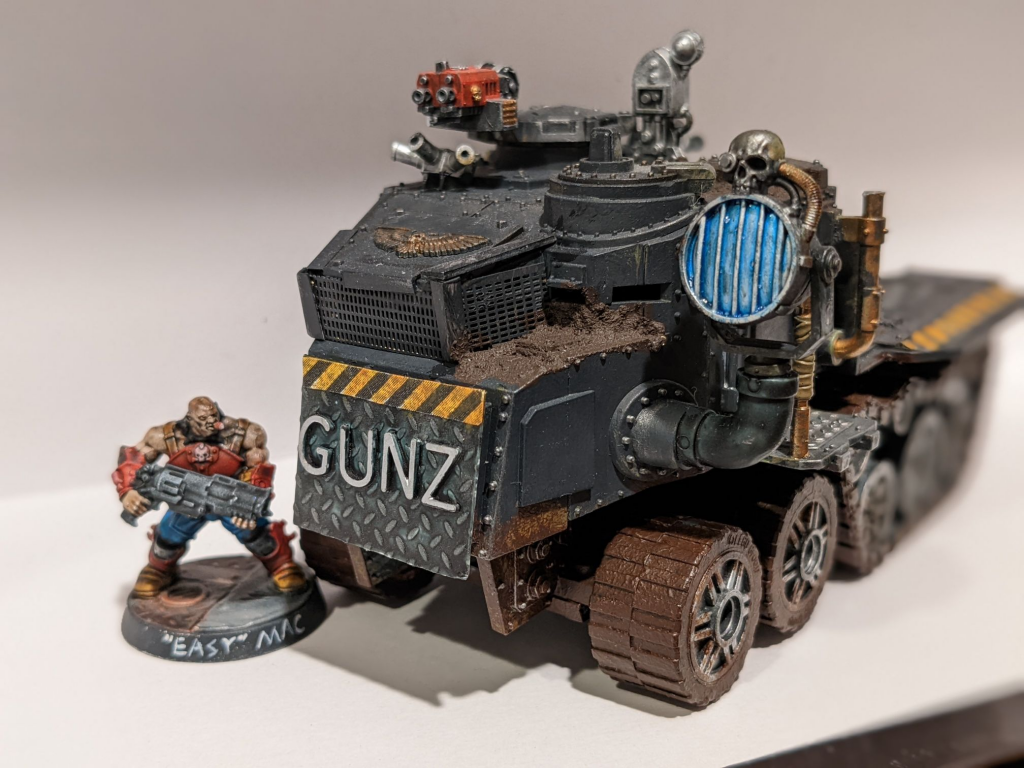
Wasteland Workshop
Primaris Kevin: Divided into two sections; Designing Your Own Vehicle and a list of vehicles that are universally available (except for the Orlock Outrider Quad). Every gang can get a Cargo-8 Ridgehauler, Rockgrinder, Ridgerunner, or Wolfquad. Basically all of the civilian vehicles previously from the Genestealer Cults line, along with the Orlock ride from the Ash Wastes box.
Custom vehicles have the player start with a template (light, medium, or heavy vehicle with wheeled or tracked mobility, or a walker). All vehicles start with nominal statlines that are roughly equivalent to the universal vehicle options, but carry either 1 weapon hardpoint (with the exception of the heavy which gets two). Players then get access to a limited selection of vehicle upgrades, weapons, and wargear from the Custom Vehicle Equipment List. During the course of the campaign players can upgrade the vehicles further by applying any upgrade that they can get from the Trading Post or Black Market. All custom vehicles have the Jury-rigged rule which doubles the credit cost of any repairs.
The starting options are fairly limited, and the ability to have a skimmer requires a Rare purchase from the Trading Post (Van Saar can find it easier than others). What this means is that players who want to do cool things like having flying cars will have to wait until the campaign proceeds.
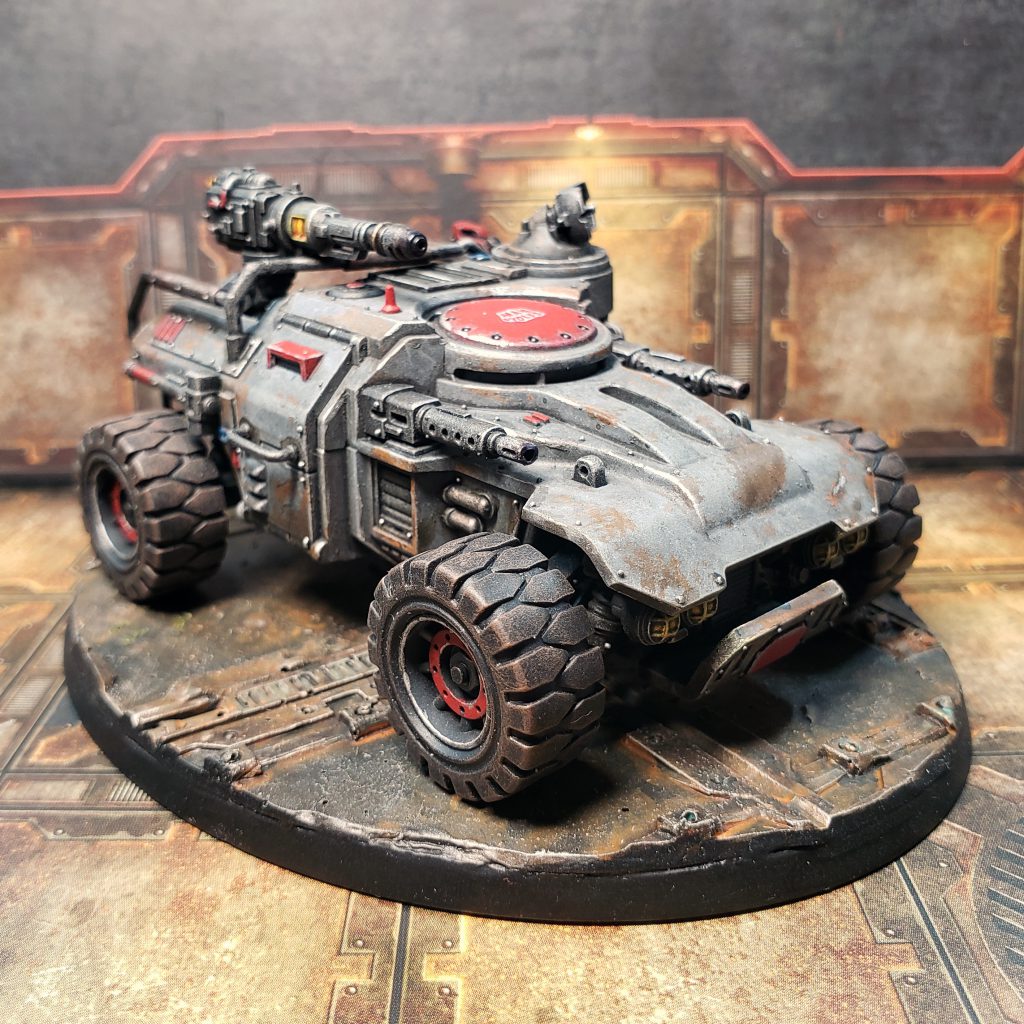
The standard vehicles are limited to the upgrades available from their respective lists, meaning vehicles like the Ridgerunner will never be able to get Extra Armour and have a boosted toughness.
The Jury-Rigged rule is BRUTAL and means that players who want to repair Lasting Damage will almost certainly be paying the full price to repair their vehicle.
The Wolfquad is a slower, weaker, and more cumbersome version of the Orlock quad. The Ridgerunner is slightly better armored but comes with two hardpoints and a small open space for passengers, making it very appealing at the 95 credit price point. The Rockgrinder is tough (T7), has two hardpoints, passenger space, and costs 145 credits making it appealing depending on what guns you give it.
The Cargo-8 is incredibly tough (T9 in the front, T8 elsewhere), is expensive at 230 credits before toys, and has the ability to carry up to 4 trailers that can also have guns on them. The Cargo-8 also has a Valuable Cargo rule that lets it provide D3x10 credits for every cargo load (1 in the cab, up to 4 trailers) that survive in the end. Players can either add a munitorum armored container for 50 credits which adds to hardpoints, or a promethium tank for 30 credits. The promethium tank is insane; every time the Ridgehauler is hit you roll a D6 from the High-pressure Gas rule. If the sum of the die roll and Strength of the attacking weapon is 9 or higher then the tank is pierced and spews forth a stream of gas that will either blind or potentially set nearby folks on fire. On the plus side every tank is worth an extra D6x10 credits and as far as we can tell the tank is still worth money even if it starts to leak, and flamer weapons are easier to reload within 3” of the tank. So if you have the 900 credits for a full promethium train then you can make 5D6x10 + 5D3x10 credits if you survive, which is an average of 275 credits per haul.
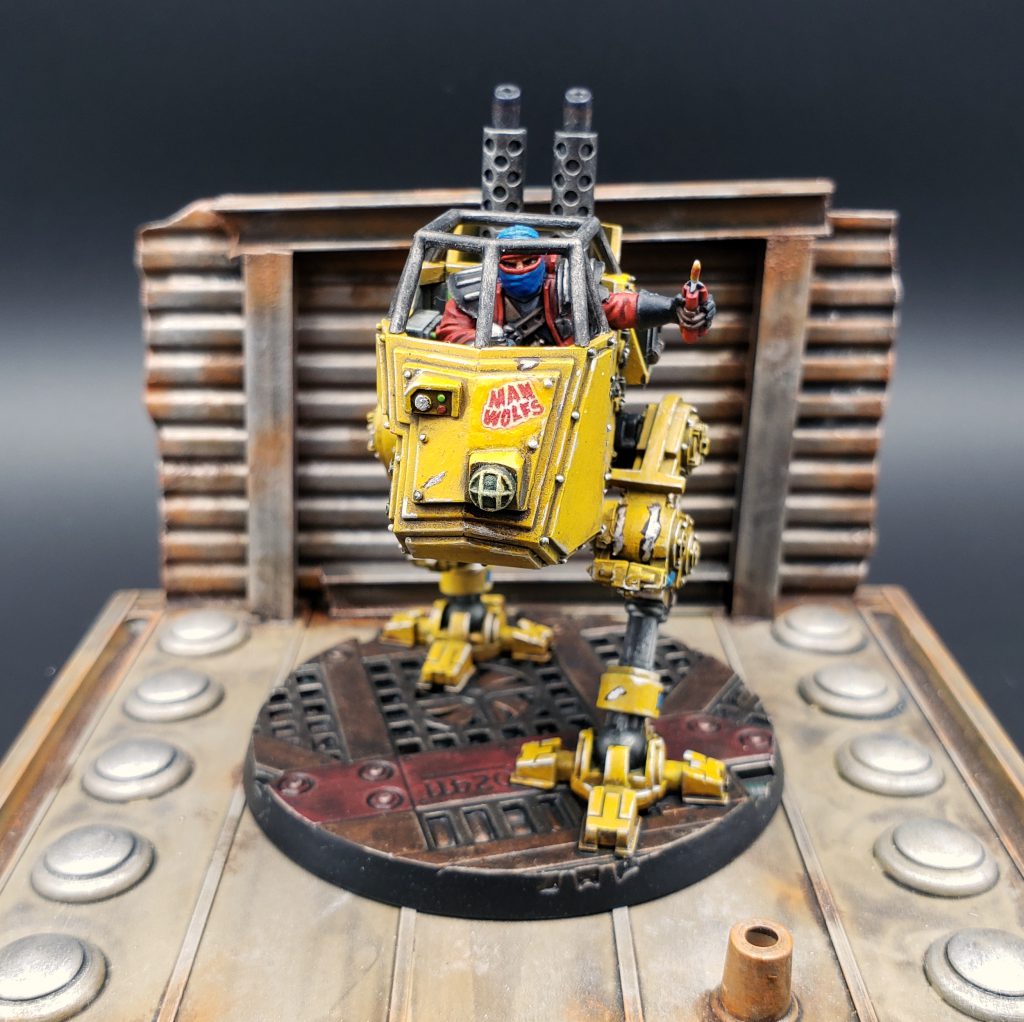
Vehicle Upgrades
Genghis Cohen: One point to note is that all vehicles, set and custom, have a maximum number of Vehicle Upgrades they can take in the Drive, Engine, and Body categories. This seems to be guided by the size of the model and what’s plausible. For example the Orlock Outrider Quad cannot take any Body upgrades – it barely has a body, being stripped down as light as possible, so adding armour or a Crash Cage wouldn’t be possible. Each of the set vehicles (Wolfquad, Ridgerunner, Rockgrinder, Ridgehauler) has a defined list of which Vehicle Upgrades it can take, as well. Custom vehicles can take any upgrade, although some specific upgrades have their own limitations, e.g. a Transport Bed cannot be added to a Walker vehicle. Any vehicle can also access Vehicle Wargear. Again, set vehicles have defined lists they can buy from automatically, but unlike for Upgrades, all vehicles can shop at the Trading Post for Wargear.
What jumps out is that any vehicle, not just custom jobs, can have any Basic, Special or Heavy Weapon from the Trading Post. So if we started an Orlock Gang and included an Outrider Quad, we could only equip it with a Heavy Bolter or Harpoon Launcher at the outset. But we could visit the Trading Post after the first campaign game, and (Rarity and Credits permitting) slap a multi-melta on there. Any combination goes!
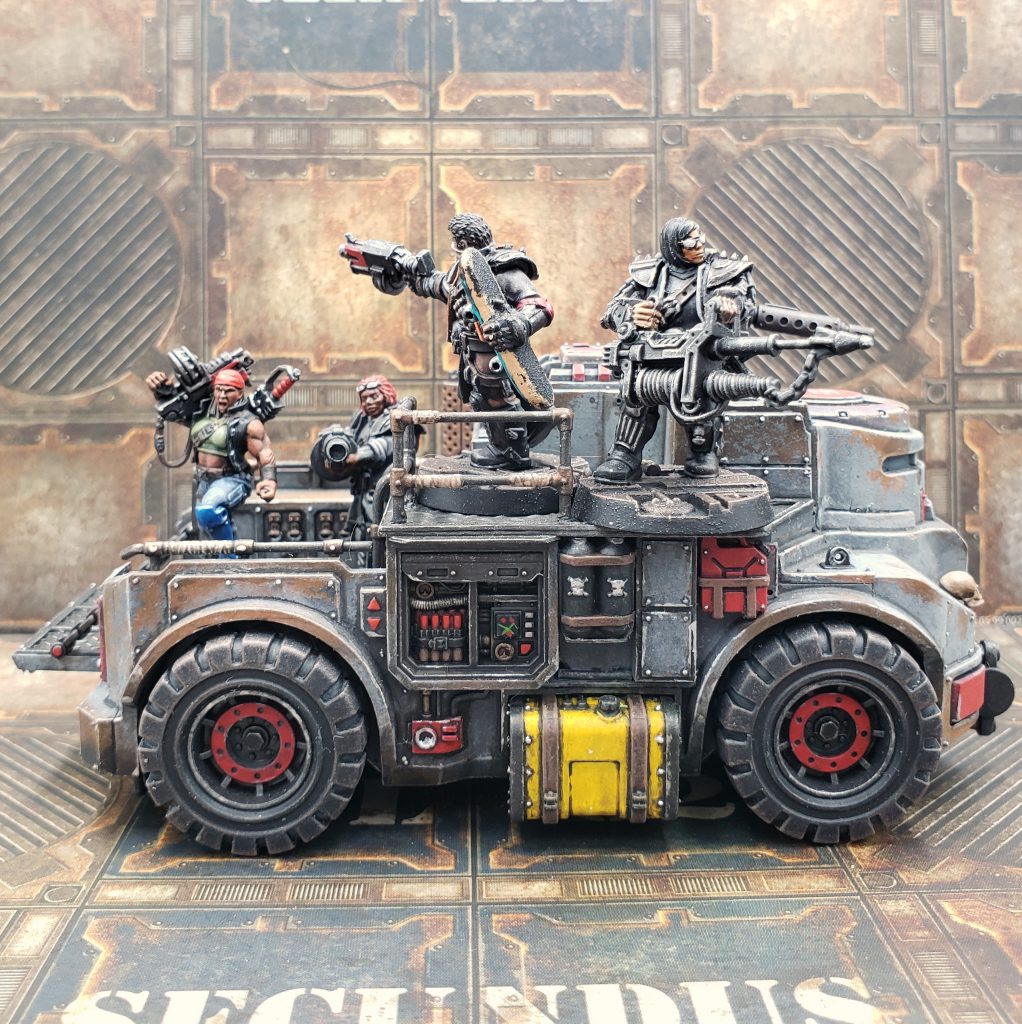
The custom vehicle starting statlines (Light, Medium and Heavy) more or less parallel the Wolfquad, Ridgerunner and Rockgrinder. Our initial impression is the light and heavy chassis are flat out worse, with the medium option a toss-up of tweaked stats. This is in line with the designers stated intent that the goal is to enable freedom of design, not to make the most powerful war machine in the wasteland.
The custom options are ALL seem worse when you take into account the upgrades the generic vehicles get. I might prefer the ‘medium vehicle’ profile to the Ridgerunner, but it comes with 1 weapon hardpoint and no transport capacity, while the Ridgerunner has 2 hardpoints and a small bay at the back for one or two passengers. A custom vehicle would have to pay an additional 55 credits for those.
- Comparison:
- A Ridgerunner is 95 credits, 7”, 5/4/4, 3HP, 7+ Hand, 5+ Save and has two hardpoints, 2/3/2 upgrades, and a transport area.
- A medium vehicle is 130 credits and a 6”, 5/5/5, 3HP, 7+ Hand, 4+ Save. 1 hardpoint, 2/2/3 upgrade options.
- So the stat difference is that the Ridgerunner is faster, but has 1 less Toughness on the sides and one less Save
- Extra armour is 25 credits to make toughness better, but the Ridgerunner can’t take it because it’s not in their Upgrade list. Oddly enough there’s no upgrade available to increase Save.
- Medium vehicle would spend 15 credits for a Nitro burner to get to 7” move, 40 credits for a hardpoint, and 15 credits for a transport bed. So the closest you can get would have the Ridgerunner at 115 credits with one upgrade, and the medium vehicle at 200 credits with three upgrades. At that point the medium vehicle would be slightly tougher and have a better save.
- Aha, but Ridgerunners cannot take Extra Armour for +1T, because it isn’t in their Upgrade list! This is a good example for our readers of the pros and cons of vehicle building.
- In summary, custom vehicles are somewhat penalised in terms of cost and raw stats, and they aren’t infinitely variable – for instance, there are no heavy, fast vehicles in the Wastes. But the set vehicles pretty much are what they are, custom vehicles do give you more mutability.
Fun fact; as far as I can tell there’s nothing stopping you from buying a weapon for the vehicle (say a missile launcher for a Ridgerunner), putting it in the Stash, and then letting a ganger take it for themselves.
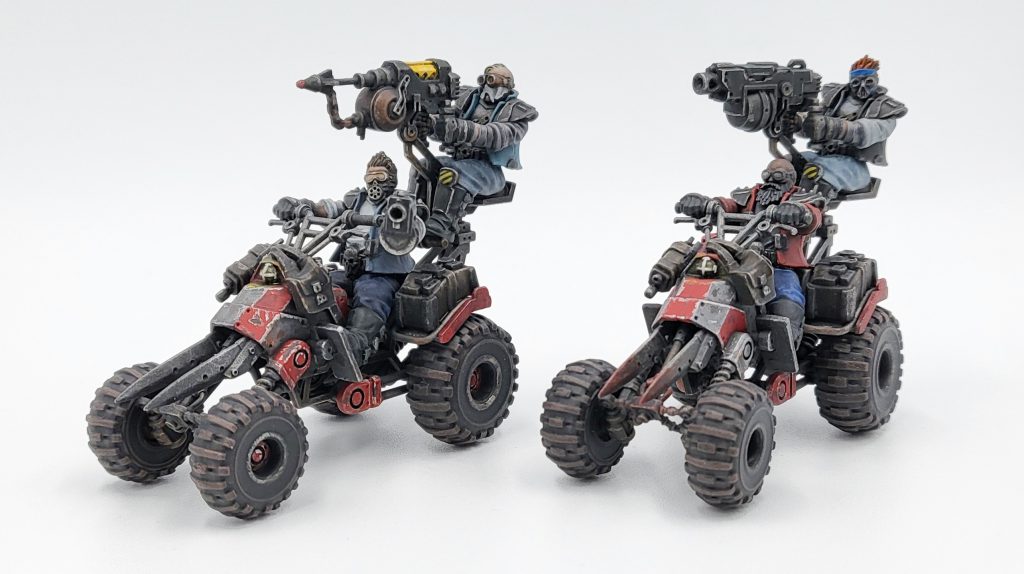
Genghis Cohen: I’m in awe of the absolute rustbucket that is the light vehicle custom chassis. For only 50 credits, you get a vehicle with 1 Hull Point, meaning that most any non-Glancing hit will wreck it straight away. It’s definitively worse than either the Wolfquad or Orlock Outrider Quad. Although you could go to the Trading Post for Reinforced Armour upgrade, which would get it up to its competitors’ 2HP, it would then cost the same as a Wolfquad, with worse Move, Handling, and swapping the Wolfquad’s positive Agile rule (can turn more freely during a full-speed move action) for the aforementioned, punitive Jury-Rigged drawback. This is the kind of thing we mean, that custom jobs are worse than the competing vehicles.
Fowler: For 50 credits, I think I would rather buy a dirtbike and take my chances with a fighter’s inbuilt defenses!
Genghis Cohen: In common with previous Necromunda books, upgrades are sometimes steals, sometimes pointless, but as a general trend cost a lot in proportion to the base chassis you slap them on. If you spend 145 credits on a Rockgrinder, and another 145 on Upgrades and/or Wargear, you won’t ever make something as effective as 2 Rockgrinders. The exception, we suppose, is weapons, which cost as much as the vehicles themselves. For example, an Orlock Outrider Quad, unarmed but with Crew, is 115 credits. A Heavy Bolter for it cost 160, the same as it would for a dismounted fighter. It will be interesting to see some gangs experiment with unarmed or lightly armed vehicles for Objective-based scenarios, such as the Bone Road Death Race.
Fowler: This is a case where it feels like I will need some reps to figure it one out. Given where things are at now – it’s almost as if this sets up some amazing skirmish scenarios but may incentivize some odd hoarding or conservative starts in a campaign. The one thing I did determine from the few games I played before the Ash Wastes box came out – other than the Death Race, I found that vehicle-based games were decisively shooty with pretty quick innings.
Genghis Cohen: While the custom design rules here are robust and usable, I feel I would probably push the envelope a bit further as an Arbitrator. You can’t create custom vehicles on the scale of the Ridge Hauler, although you could use its huge Upgrades list to represent a widely converted range of vehicles. If your imagined vehicle doesn’t fit the scale of the light/medium/heavy categories envisioned, or a very slow light walker, then you have very limited ability to alter their stats with Upgrades. You can’t really have a fast, heavy vehicle for example, although you could somewhat increase the Movement of the heavy starting chassis. I suppose it’s better to put a framework on these things, since sufficiently imaginative groups can always come up with custom chassis and then use the book’s rules for Upgrades, weapon hardpoints etc.
Fowler: Right off the bat, I would not charge double for repairs in my campaign. That said, I have a sneaking suspicion that there are some oppressive upgrade wombo-combos which could use some monitoring.
A Brief Discussion About the Models
Fowler: We are working on future articles with more details about the models that released alongside Book of the Outlands, but we wanted to talk a bit about the kits.
Ironhead Squat Prospectors
This is a very multipart kit. The neck and shoulders are ball joints – while there is a “golden angle” that arms are meant to rest in, you have some freedom with poses. For every sprue of 4 bodies you get:
- 3 empty right hands (1 with Bio-Booster)
- 2 autoguns
- 1 autopistol
- 1 boltgun
- 2 bolt Pistols
- 1 heavy stubber
- 1 big hammer
- 1 shoulder mounted laser thing
- 5 face / helmet options
- 5 open visors
- 1 closed visor
The kit does not contain:
- Hand flamer
- Flamer
- Melta
- Heavy flamer
- Mining laser
- “GEM EXTRACTOR”
- Arc welder
- Bunch of power weapons
Ash Waste Nomads
We’ve covered options previously, so let’s talk about options it does not contain:
- Scavenged Autogun
- Scavenged Stub Gun
- Web pistol
- Venom caster
- Web Gun
- Heavy Blaster
Cargo-8 Ridgehauler
While the rules for the Ridgehauler have Munitorum Container and Promethium Tank options, only the container is in the kit. I plan to represent it with a pile of barrels… but the issue is that the container and flatbed kit options are different assemblies!
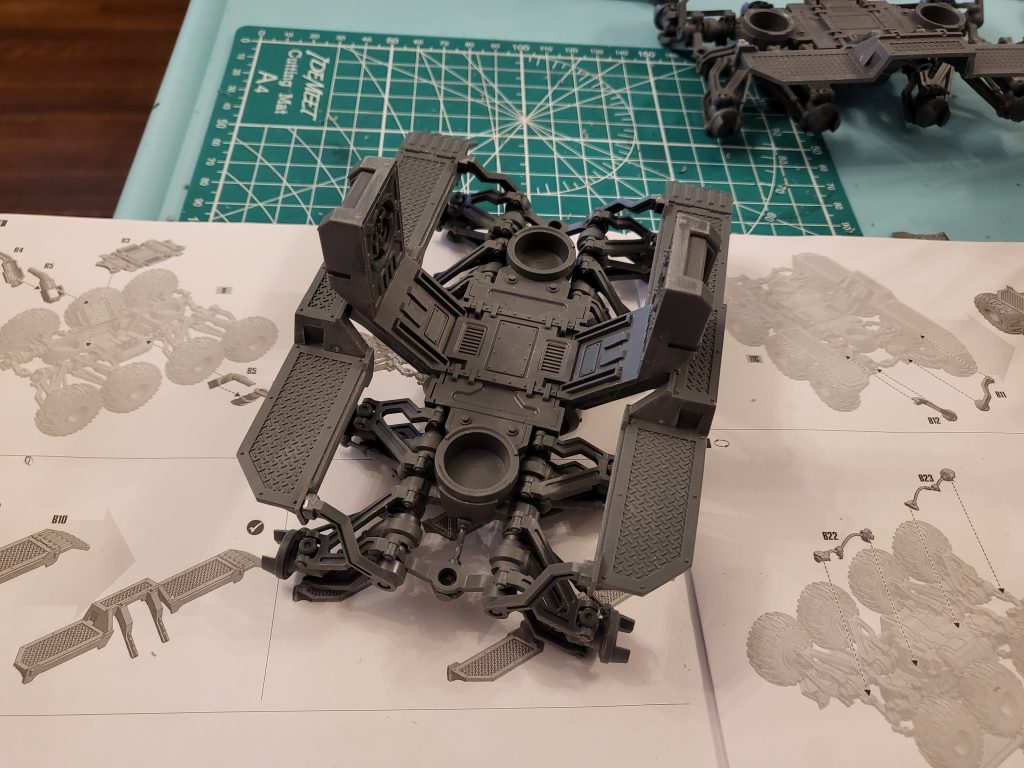
It’s pretty easy to make this modular so you can use either option!
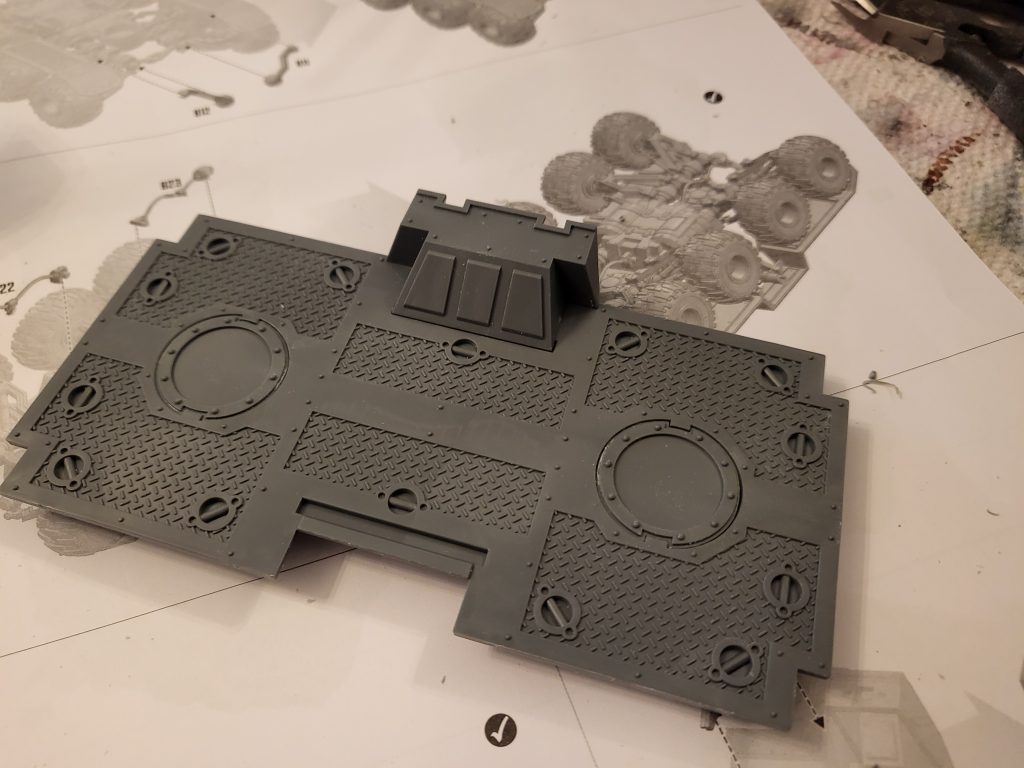
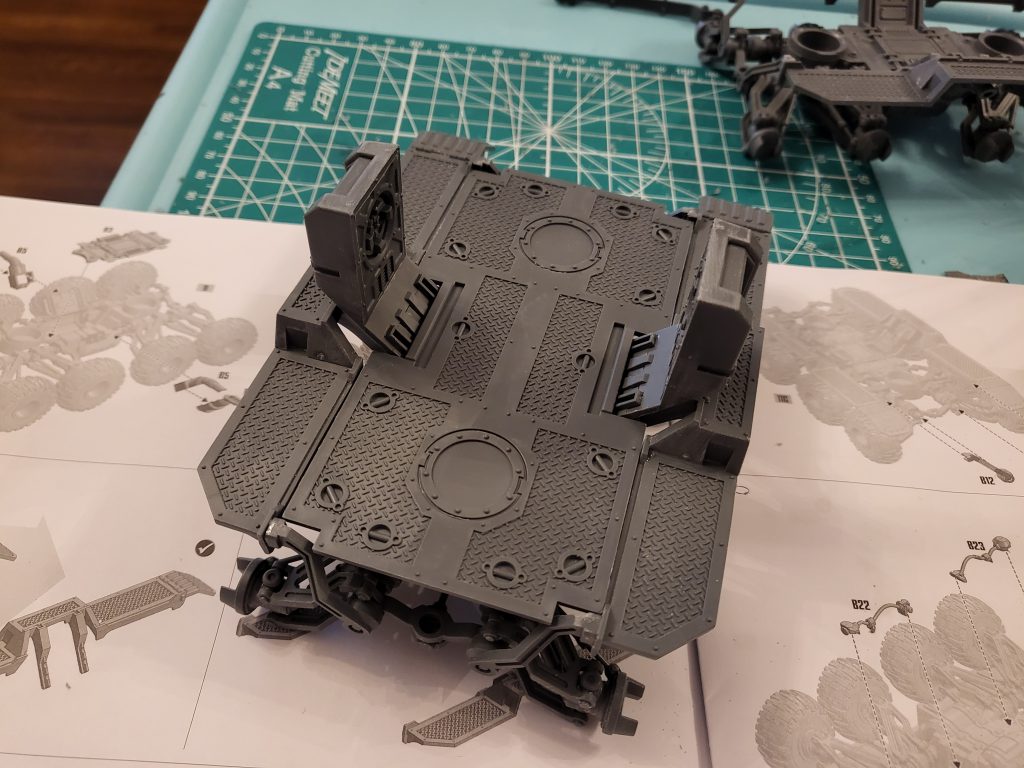
You may also note that the wheels aren’t on – I opted to paint the tires in subassembly to speed up the process of painting the main chassis. It’s also worth considering leaving the crew to paint separately as well – the kit is well designed to do so. The gunners clip in, and the top of the cab can be left off easily.
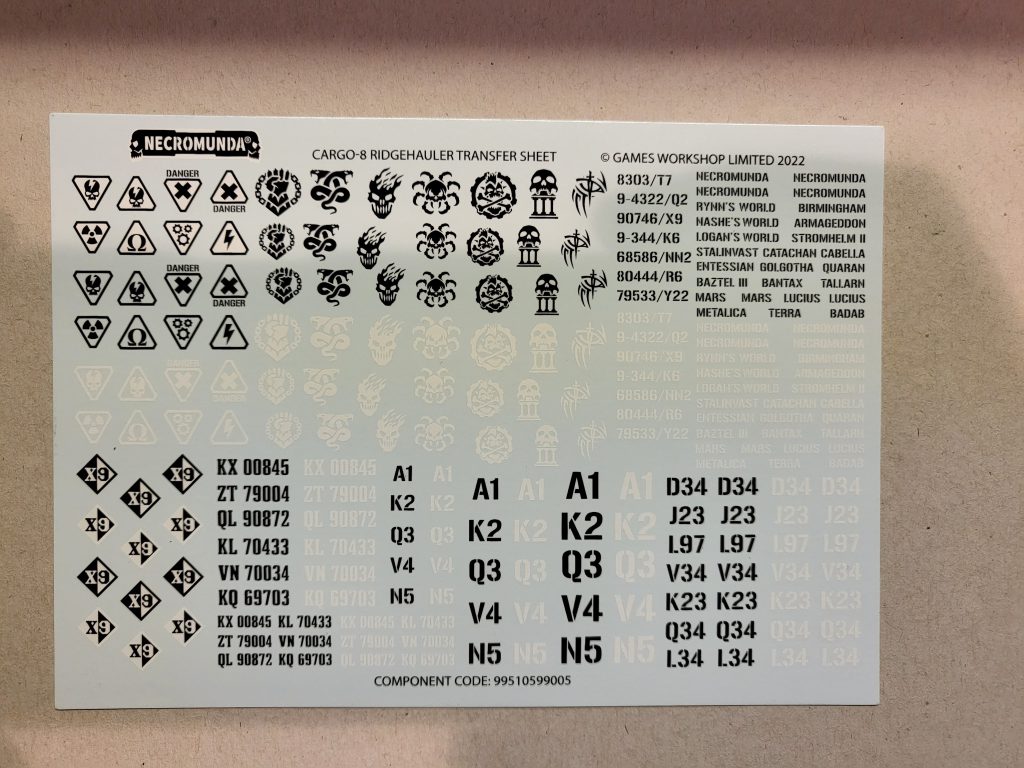
It’s also worth mentioning that both the Cargo-8 Ridgehauler and trailer kit come with this amazing transfer sheet. It’s got all of the house iconography, some warnings, a TON of planets, and plenty of identification numbers.
Conclusion
If vehicle combat is what you are after, this book is for you. Confused about the difference between Outlands and Ash Wastes? Let’s break down what rules are available in which book.
Both books
- Core vehicle rules
- Battlefield conditions
Ash Wastes
- Core Necromunda rules
- Psyker rules
- Skills
- Ash Wastes Campaign
- Ash Wastes Scenarios
Book of the Outlands
- Wasteland Gangs rules (how to use any gang in the Ash Wastes, crew rules)
- Wasteland Workshop (generic & custom vehicles)
- Ash Waste Nomads gang list
- Ironhead Squat Prospectors gang list
Outlands provides (almost) every gang with a sizeable pile of toys, two complete gang lists, and a few nasty “new” exotic beasts. GW has delivered the rest of the vehicle ruleset, and it looks fun as hell.
And that’s it! At least nearly 5,000 words later we certainly hope so. We have quite a lot of Ash Wastes content coming your way, but if you have any questions or suggestions drop us a line at Necromunday@Goonhammer.com. We’ll be back soon with more talk about the Book of the Outlands.
